Lincoln and his emotions Unit details EPE111 Student name Ruth Oshini Kurukulasooriya
VerifiedAdded on 2021/10/07
|9
|2852
|480
AI Summary
While its easier to put emphasis on a child’s intellectual skills during their early years, it is also critical for them to develop their social and emotional skills, cognitive skills, moral skills and language acquisition. This essay examines certain theoretical pedagogies based on a scenario that I witnessed in a real-life scenario during my previous placement involving a toddler who was experiencing emotional distress and had trouble forming safe and secure relationships. Lincoln who was 1 year and 8 months old was in an active environment
Contribute Materials
Your contribution can guide someone’s learning journey. Share your
documents today.
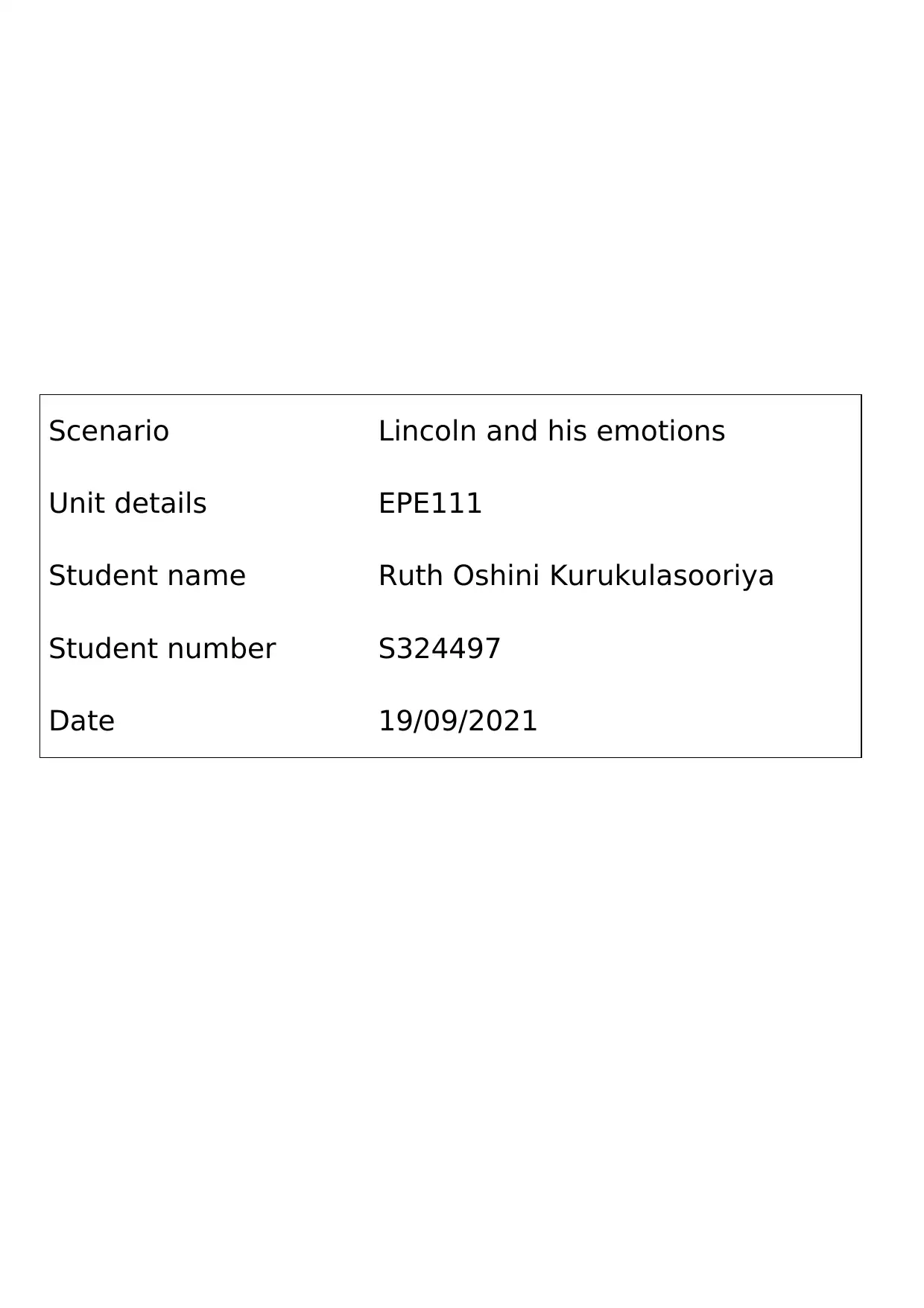
Scenario Lincoln and his emotions
Unit details EPE111
Student name Ruth Oshini Kurukulasooriya
Student number S324497
Date 19/09/2021
Unit details EPE111
Student name Ruth Oshini Kurukulasooriya
Student number S324497
Date 19/09/2021
Secure Best Marks with AI Grader
Need help grading? Try our AI Grader for instant feedback on your assignments.
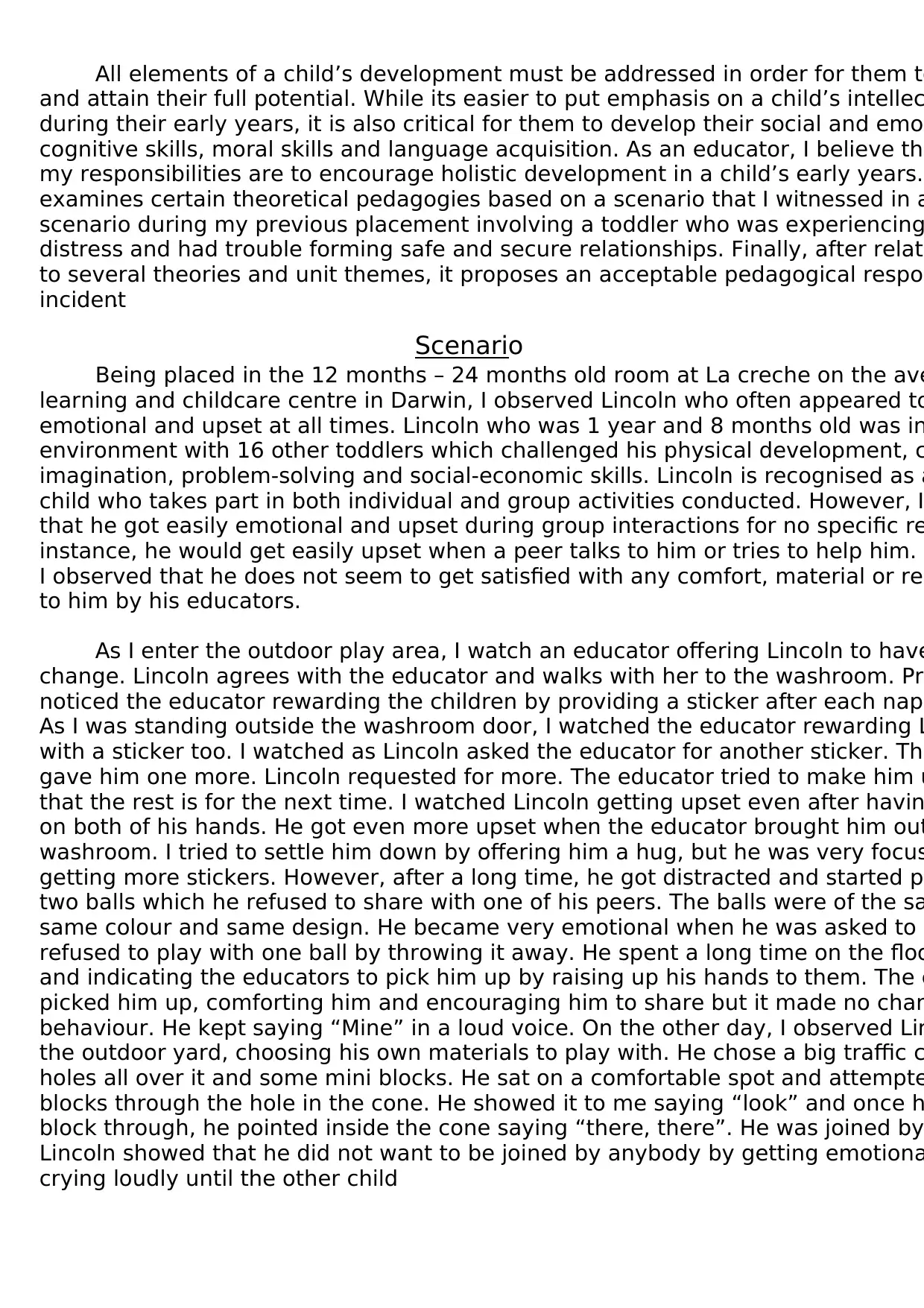
All elements of a child’s development must be addressed in order for them to
and attain their full potential. While its easier to put emphasis on a child’s intellec
during their early years, it is also critical for them to develop their social and emot
cognitive skills, moral skills and language acquisition. As an educator, I believe tha
my responsibilities are to encourage holistic development in a child’s early years.
examines certain theoretical pedagogies based on a scenario that I witnessed in a
scenario during my previous placement involving a toddler who was experiencing
distress and had trouble forming safe and secure relationships. Finally, after relati
to several theories and unit themes, it proposes an acceptable pedagogical respon
incident.
Scenario
Being placed in the 12 months – 24 months old room at La creche on the ave
learning and childcare centre in Darwin, I observed Lincoln who often appeared to
emotional and upset at all times. Lincoln who was 1 year and 8 months old was in
environment with 16 other toddlers which challenged his physical development, c
imagination, problem-solving and social-economic skills. Lincoln is recognised as a
child who takes part in both individual and group activities conducted. However, I
that he got easily emotional and upset during group interactions for no specific re
instance, he would get easily upset when a peer talks to him or tries to help him. F
I observed that he does not seem to get satisfied with any comfort, material or rew
to him by his educators.
As I enter the outdoor play area, I watch an educator offering Lincoln to have
change. Lincoln agrees with the educator and walks with her to the washroom. Pre
noticed the educator rewarding the children by providing a sticker after each napp
As I was standing outside the washroom door, I watched the educator rewarding L
with a sticker too. I watched as Lincoln asked the educator for another sticker. The
gave him one more. Lincoln requested for more. The educator tried to make him u
that the rest is for the next time. I watched Lincoln getting upset even after havin
on both of his hands. He got even more upset when the educator brought him out
washroom. I tried to settle him down by offering him a hug, but he was very focus
getting more stickers. However, after a long time, he got distracted and started pl
two balls which he refused to share with one of his peers. The balls were of the sa
same colour and same design. He became very emotional when he was asked to s
refused to play with one ball by throwing it away. He spent a long time on the floo
and indicating the educators to pick him up by raising up his hands to them. The e
picked him up, comforting him and encouraging him to share but it made no chan
behaviour. He kept saying “Mine” in a loud voice. On the other day, I observed Lin
the outdoor yard, choosing his own materials to play with. He chose a big traffic c
holes all over it and some mini blocks. He sat on a comfortable spot and attempte
blocks through the hole in the cone. He showed it to me saying “look” and once h
block through, he pointed inside the cone saying “there, there”. He was joined by
Lincoln showed that he did not want to be joined by anybody by getting emotiona
crying loudly until the other child
and attain their full potential. While its easier to put emphasis on a child’s intellec
during their early years, it is also critical for them to develop their social and emot
cognitive skills, moral skills and language acquisition. As an educator, I believe tha
my responsibilities are to encourage holistic development in a child’s early years.
examines certain theoretical pedagogies based on a scenario that I witnessed in a
scenario during my previous placement involving a toddler who was experiencing
distress and had trouble forming safe and secure relationships. Finally, after relati
to several theories and unit themes, it proposes an acceptable pedagogical respon
incident.
Scenario
Being placed in the 12 months – 24 months old room at La creche on the ave
learning and childcare centre in Darwin, I observed Lincoln who often appeared to
emotional and upset at all times. Lincoln who was 1 year and 8 months old was in
environment with 16 other toddlers which challenged his physical development, c
imagination, problem-solving and social-economic skills. Lincoln is recognised as a
child who takes part in both individual and group activities conducted. However, I
that he got easily emotional and upset during group interactions for no specific re
instance, he would get easily upset when a peer talks to him or tries to help him. F
I observed that he does not seem to get satisfied with any comfort, material or rew
to him by his educators.
As I enter the outdoor play area, I watch an educator offering Lincoln to have
change. Lincoln agrees with the educator and walks with her to the washroom. Pre
noticed the educator rewarding the children by providing a sticker after each napp
As I was standing outside the washroom door, I watched the educator rewarding L
with a sticker too. I watched as Lincoln asked the educator for another sticker. The
gave him one more. Lincoln requested for more. The educator tried to make him u
that the rest is for the next time. I watched Lincoln getting upset even after havin
on both of his hands. He got even more upset when the educator brought him out
washroom. I tried to settle him down by offering him a hug, but he was very focus
getting more stickers. However, after a long time, he got distracted and started pl
two balls which he refused to share with one of his peers. The balls were of the sa
same colour and same design. He became very emotional when he was asked to s
refused to play with one ball by throwing it away. He spent a long time on the floo
and indicating the educators to pick him up by raising up his hands to them. The e
picked him up, comforting him and encouraging him to share but it made no chan
behaviour. He kept saying “Mine” in a loud voice. On the other day, I observed Lin
the outdoor yard, choosing his own materials to play with. He chose a big traffic c
holes all over it and some mini blocks. He sat on a comfortable spot and attempte
blocks through the hole in the cone. He showed it to me saying “look” and once h
block through, he pointed inside the cone saying “there, there”. He was joined by
Lincoln showed that he did not want to be joined by anybody by getting emotiona
crying loudly until the other child
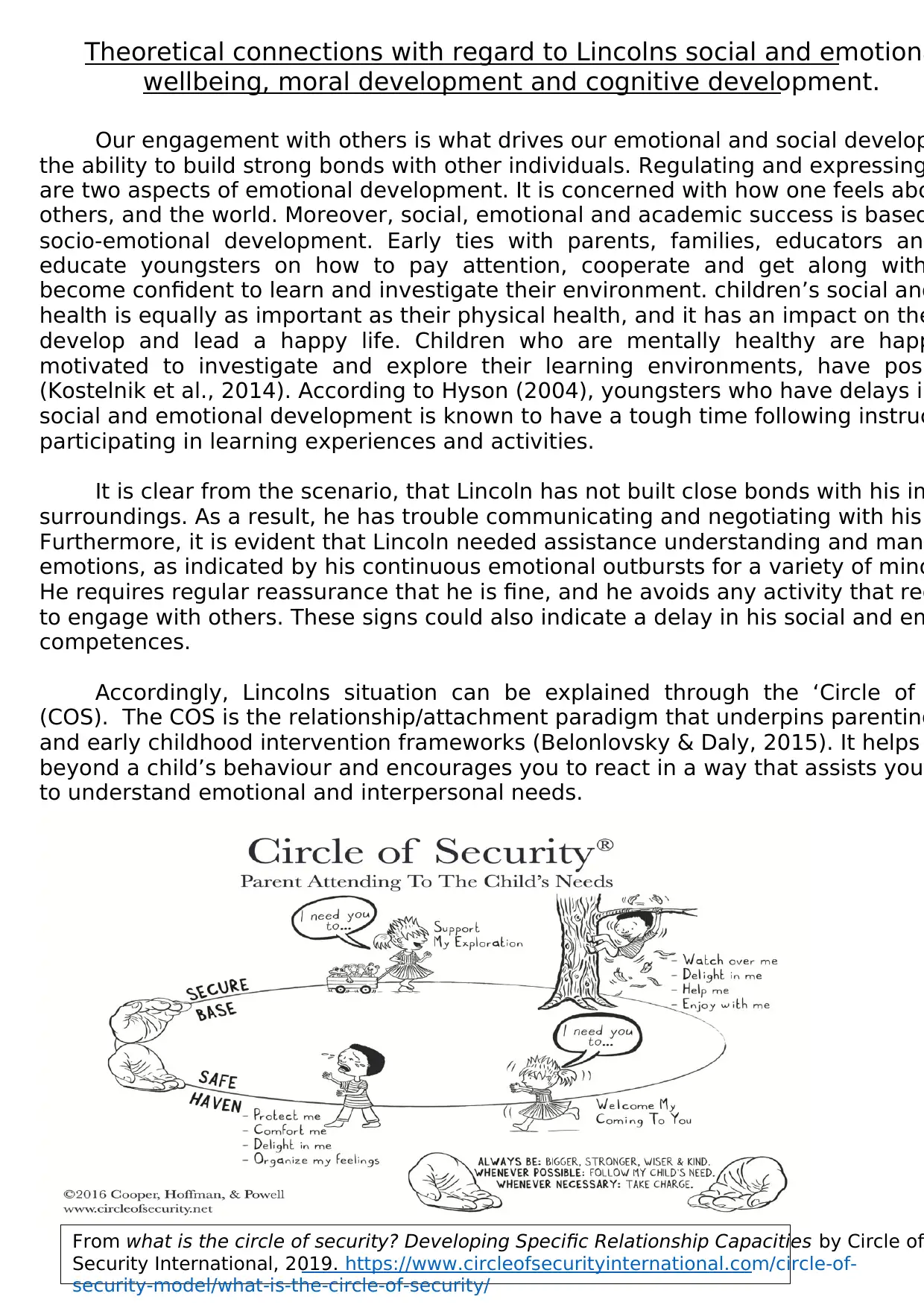
Theoretical connections with regard to Lincolns social and emotiona
wellbeing, moral development and cognitive development.
Our engagement with others is what drives our emotional and social develop
the ability to build strong bonds with other individuals. Regulating and expressing
are two aspects of emotional development. It is concerned with how one feels abo
others, and the world. Moreover, social, emotional and academic success is based
socio-emotional development. Early ties with parents, families, educators and
educate youngsters on how to pay attention, cooperate and get along with
become confident to learn and investigate their environment. children’s social and
health is equally as important as their physical health, and it has an impact on the
develop and lead a happy life. Children who are mentally healthy are happ
motivated to investigate and explore their learning environments, have posi
(Kostelnik et al., 2014). According to Hyson (2004), youngsters who have delays in
social and emotional development is known to have a tough time following instruc
participating in learning experiences and activities.
It is clear from the scenario, that Lincoln has not built close bonds with his im
surroundings. As a result, he has trouble communicating and negotiating with his
Furthermore, it is evident that Lincoln needed assistance understanding and mana
emotions, as indicated by his continuous emotional outbursts for a variety of mino
He requires regular reassurance that he is fine, and he avoids any activity that req
to engage with others. These signs could also indicate a delay in his social and em
competences.
Accordingly, Lincolns situation can be explained through the ‘Circle of
(COS). The COS is the relationship/attachment paradigm that underpins parenting
and early childhood intervention frameworks (Belonlovsky & Daly, 2015). It helps
beyond a child’s behaviour and encourages you to react in a way that assists you
to understand emotional and interpersonal needs.
From what is the circle of security? Developing Specific Relationship Capacities by Circle of
Security International, 2019. https://www.circleofsecurityinternational.com/circle-of-
security-model/what-is-the-circle-of-security/
wellbeing, moral development and cognitive development.
Our engagement with others is what drives our emotional and social develop
the ability to build strong bonds with other individuals. Regulating and expressing
are two aspects of emotional development. It is concerned with how one feels abo
others, and the world. Moreover, social, emotional and academic success is based
socio-emotional development. Early ties with parents, families, educators and
educate youngsters on how to pay attention, cooperate and get along with
become confident to learn and investigate their environment. children’s social and
health is equally as important as their physical health, and it has an impact on the
develop and lead a happy life. Children who are mentally healthy are happ
motivated to investigate and explore their learning environments, have posi
(Kostelnik et al., 2014). According to Hyson (2004), youngsters who have delays in
social and emotional development is known to have a tough time following instruc
participating in learning experiences and activities.
It is clear from the scenario, that Lincoln has not built close bonds with his im
surroundings. As a result, he has trouble communicating and negotiating with his
Furthermore, it is evident that Lincoln needed assistance understanding and mana
emotions, as indicated by his continuous emotional outbursts for a variety of mino
He requires regular reassurance that he is fine, and he avoids any activity that req
to engage with others. These signs could also indicate a delay in his social and em
competences.
Accordingly, Lincolns situation can be explained through the ‘Circle of
(COS). The COS is the relationship/attachment paradigm that underpins parenting
and early childhood intervention frameworks (Belonlovsky & Daly, 2015). It helps
beyond a child’s behaviour and encourages you to react in a way that assists you
to understand emotional and interpersonal needs.
From what is the circle of security? Developing Specific Relationship Capacities by Circle of
Security International, 2019. https://www.circleofsecurityinternational.com/circle-of-
security-model/what-is-the-circle-of-security/
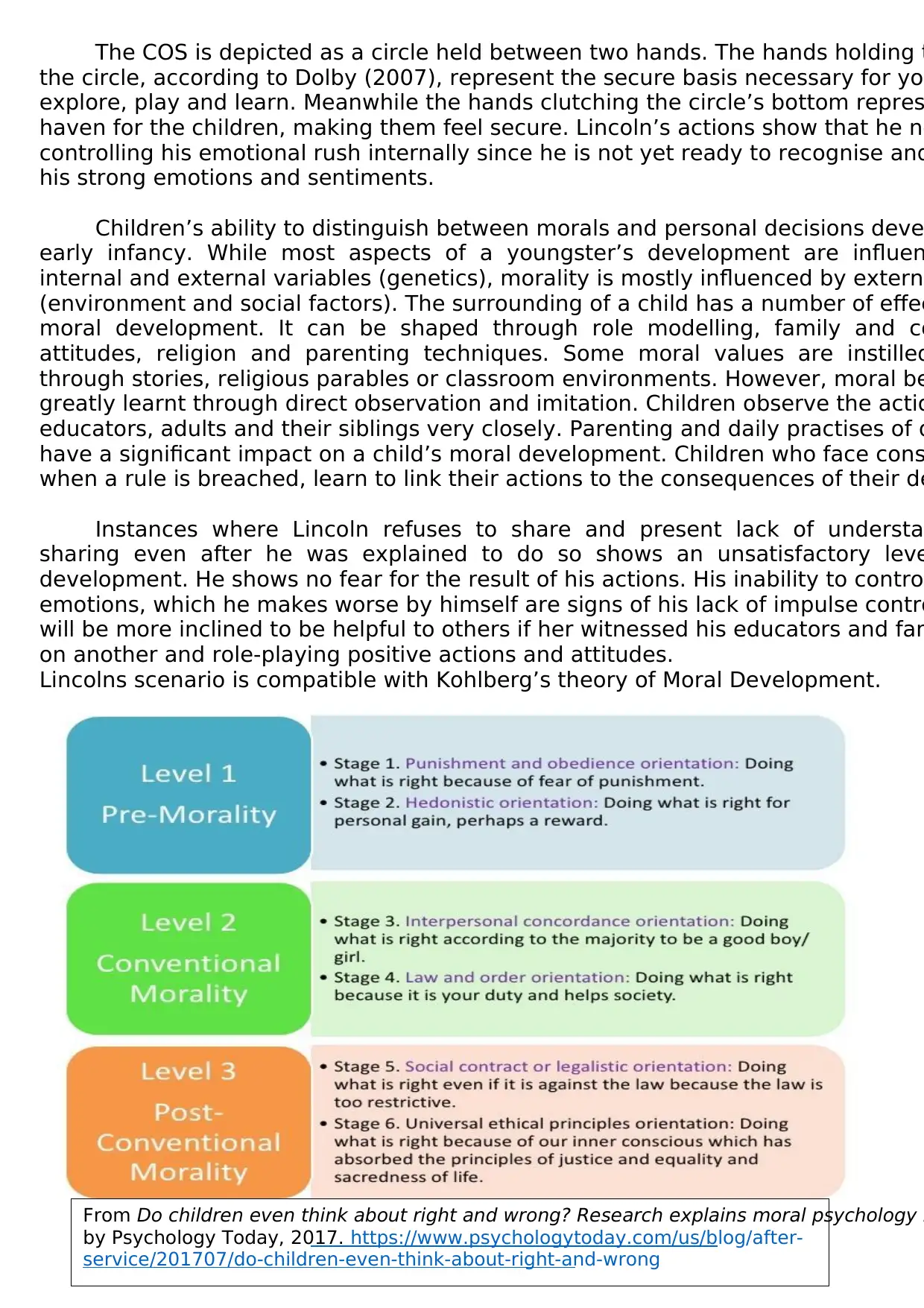
The COS is depicted as a circle held between two hands. The hands holding t
the circle, according to Dolby (2007), represent the secure basis necessary for you
explore, play and learn. Meanwhile the hands clutching the circle’s bottom repres
haven for the children, making them feel secure. Lincoln’s actions show that he ne
controlling his emotional rush internally since he is not yet ready to recognise and
his strong emotions and sentiments.
Children’s ability to distinguish between morals and personal decisions deve
early infancy. While most aspects of a youngster’s development are influen
internal and external variables (genetics), morality is mostly influenced by externa
(environment and social factors). The surrounding of a child has a number of effec
moral development. It can be shaped through role modelling, family and co
attitudes, religion and parenting techniques. Some moral values are instilled
through stories, religious parables or classroom environments. However, moral be
greatly learnt through direct observation and imitation. Children observe the actio
educators, adults and their siblings very closely. Parenting and daily practises of d
have a significant impact on a child’s moral development. Children who face cons
when a rule is breached, learn to link their actions to the consequences of their de
Instances where Lincoln refuses to share and present lack of understa
sharing even after he was explained to do so shows an unsatisfactory leve
development. He shows no fear for the result of his actions. His inability to contro
emotions, which he makes worse by himself are signs of his lack of impulse contro
will be more inclined to be helpful to others if her witnessed his educators and fam
on another and role-playing positive actions and attitudes.
Lincolns scenario is compatible with Kohlberg’s theory of Moral Development.
From Do children even think about right and wrong? Research explains moral psychology i
by Psychology Today, 2017. https://www.psychologytoday.com/us/blog/after-
service/201707/do-children-even-think-about-right-and-wrong
the circle, according to Dolby (2007), represent the secure basis necessary for you
explore, play and learn. Meanwhile the hands clutching the circle’s bottom repres
haven for the children, making them feel secure. Lincoln’s actions show that he ne
controlling his emotional rush internally since he is not yet ready to recognise and
his strong emotions and sentiments.
Children’s ability to distinguish between morals and personal decisions deve
early infancy. While most aspects of a youngster’s development are influen
internal and external variables (genetics), morality is mostly influenced by externa
(environment and social factors). The surrounding of a child has a number of effec
moral development. It can be shaped through role modelling, family and co
attitudes, religion and parenting techniques. Some moral values are instilled
through stories, religious parables or classroom environments. However, moral be
greatly learnt through direct observation and imitation. Children observe the actio
educators, adults and their siblings very closely. Parenting and daily practises of d
have a significant impact on a child’s moral development. Children who face cons
when a rule is breached, learn to link their actions to the consequences of their de
Instances where Lincoln refuses to share and present lack of understa
sharing even after he was explained to do so shows an unsatisfactory leve
development. He shows no fear for the result of his actions. His inability to contro
emotions, which he makes worse by himself are signs of his lack of impulse contro
will be more inclined to be helpful to others if her witnessed his educators and fam
on another and role-playing positive actions and attitudes.
Lincolns scenario is compatible with Kohlberg’s theory of Moral Development.
From Do children even think about right and wrong? Research explains moral psychology i
by Psychology Today, 2017. https://www.psychologytoday.com/us/blog/after-
service/201707/do-children-even-think-about-right-and-wrong
Secure Best Marks with AI Grader
Need help grading? Try our AI Grader for instant feedback on your assignments.
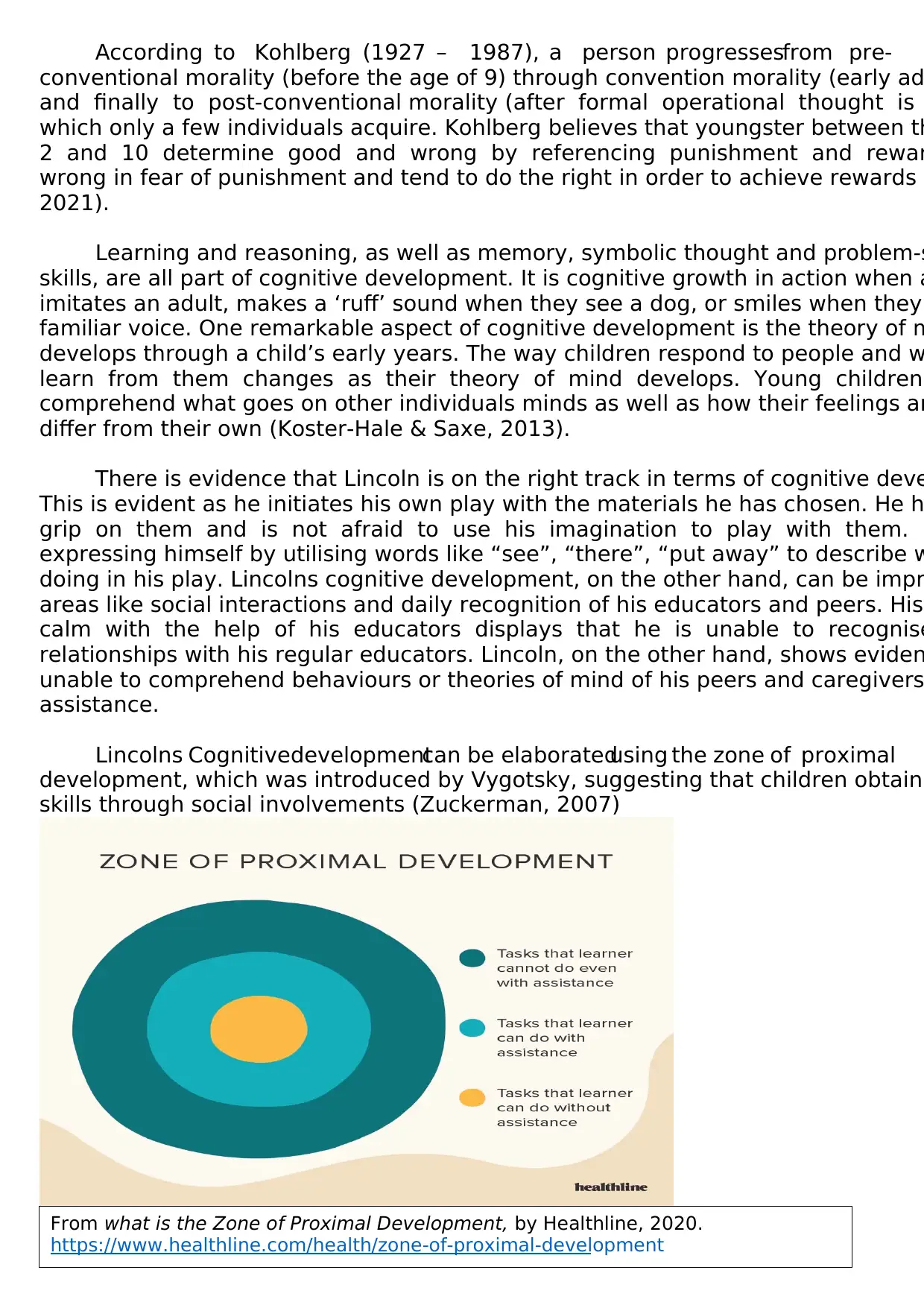
According to Kohlberg (1927 – 1987), a person progressesfrom pre-
conventional morality (before the age of 9) through convention morality (early ad
and finally to post-conventional morality (after formal operational thought is
which only a few individuals acquire. Kohlberg believes that youngster between th
2 and 10 determine good and wrong by referencing punishment and rewar
wrong in fear of punishment and tend to do the right in order to achieve rewards (
2021).
Learning and reasoning, as well as memory, symbolic thought and problem-s
skills, are all part of cognitive development. It is cognitive growth in action when a
imitates an adult, makes a ‘ruff’ sound when they see a dog, or smiles when they
familiar voice. One remarkable aspect of cognitive development is the theory of m
develops through a child’s early years. The way children respond to people and w
learn from them changes as their theory of mind develops. Young children
comprehend what goes on other individuals minds as well as how their feelings an
differ from their own (Koster-Hale & Saxe, 2013).
There is evidence that Lincoln is on the right track in terms of cognitive deve
This is evident as he initiates his own play with the materials he has chosen. He h
grip on them and is not afraid to use his imagination to play with them. H
expressing himself by utilising words like “see”, “there”, “put away” to describe w
doing in his play. Lincolns cognitive development, on the other hand, can be impr
areas like social interactions and daily recognition of his educators and peers. His
calm with the help of his educators displays that he is unable to recognise
relationships with his regular educators. Lincoln, on the other hand, shows eviden
unable to comprehend behaviours or theories of mind of his peers and caregivers
assistance.
Lincolns Cognitivedevelopmentcan be elaboratedusing the zone of proximal
development, which was introduced by Vygotsky, suggesting that children obtain
skills through social involvements (Zuckerman, 2007)
From what is the Zone of Proximal Development, by Healthline, 2020.
https://www.healthline.com/health/zone-of-proximal-development
conventional morality (before the age of 9) through convention morality (early ad
and finally to post-conventional morality (after formal operational thought is
which only a few individuals acquire. Kohlberg believes that youngster between th
2 and 10 determine good and wrong by referencing punishment and rewar
wrong in fear of punishment and tend to do the right in order to achieve rewards (
2021).
Learning and reasoning, as well as memory, symbolic thought and problem-s
skills, are all part of cognitive development. It is cognitive growth in action when a
imitates an adult, makes a ‘ruff’ sound when they see a dog, or smiles when they
familiar voice. One remarkable aspect of cognitive development is the theory of m
develops through a child’s early years. The way children respond to people and w
learn from them changes as their theory of mind develops. Young children
comprehend what goes on other individuals minds as well as how their feelings an
differ from their own (Koster-Hale & Saxe, 2013).
There is evidence that Lincoln is on the right track in terms of cognitive deve
This is evident as he initiates his own play with the materials he has chosen. He h
grip on them and is not afraid to use his imagination to play with them. H
expressing himself by utilising words like “see”, “there”, “put away” to describe w
doing in his play. Lincolns cognitive development, on the other hand, can be impr
areas like social interactions and daily recognition of his educators and peers. His
calm with the help of his educators displays that he is unable to recognise
relationships with his regular educators. Lincoln, on the other hand, shows eviden
unable to comprehend behaviours or theories of mind of his peers and caregivers
assistance.
Lincolns Cognitivedevelopmentcan be elaboratedusing the zone of proximal
development, which was introduced by Vygotsky, suggesting that children obtain
skills through social involvements (Zuckerman, 2007)
From what is the Zone of Proximal Development, by Healthline, 2020.
https://www.healthline.com/health/zone-of-proximal-development
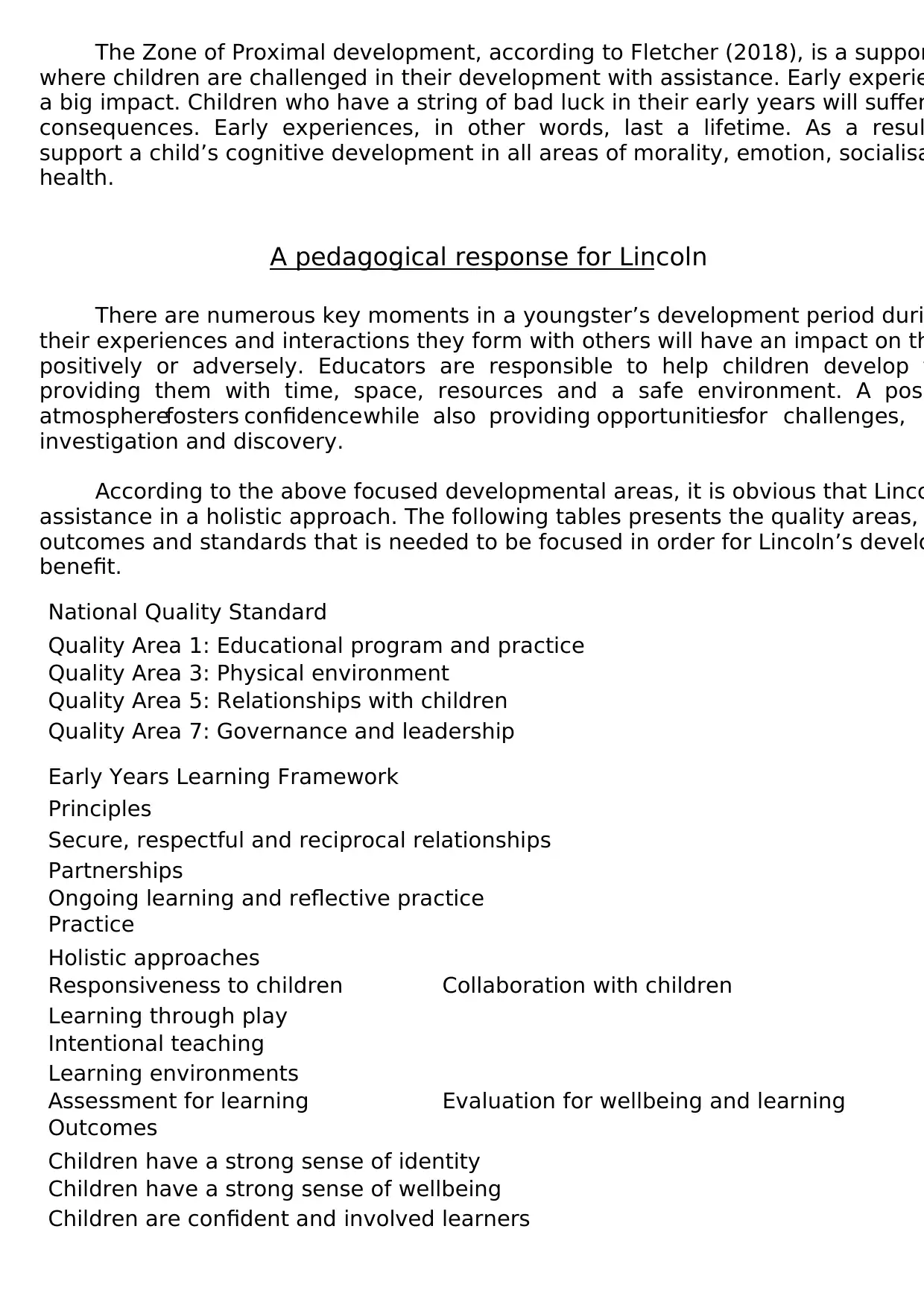
The Zone of Proximal development, according to Fletcher (2018), is a suppor
where children are challenged in their development with assistance. Early experie
a big impact. Children who have a string of bad luck in their early years will suffer
consequences. Early experiences, in other words, last a lifetime. As a resul
support a child’s cognitive development in all areas of morality, emotion, socialisa
health.
A pedagogical response for Lincoln
There are numerous key moments in a youngster’s development period duri
their experiences and interactions they form with others will have an impact on th
positively or adversely. Educators are responsible to help children develop t
providing them with time, space, resources and a safe environment. A posi
atmospherefosters confidencewhile also providing opportunitiesfor challenges,
investigation and discovery.
According to the above focused developmental areas, it is obvious that Linco
assistance in a holistic approach. The following tables presents the quality areas,
outcomes and standards that is needed to be focused in order for Lincoln’s develo
benefit.
National Quality Standard
Quality Area 1: Educational program and practice
Quality Area 3: Physical environment
Quality Area 5: Relationships with children
Quality Area 7: Governance and leadership
Early Years Learning Framework
Principles
Secure, respectful and reciprocal relationships
Partnerships
Ongoing learning and reflective practice
Practice
Holistic approaches
Responsiveness to children Collaboration with children
Learning through play
Intentional teaching
Learning environments
Assessment for learning Evaluation for wellbeing and learning
Outcomes
Children have a strong sense of identity
Children have a strong sense of wellbeing
Children are confident and involved learners
where children are challenged in their development with assistance. Early experie
a big impact. Children who have a string of bad luck in their early years will suffer
consequences. Early experiences, in other words, last a lifetime. As a resul
support a child’s cognitive development in all areas of morality, emotion, socialisa
health.
A pedagogical response for Lincoln
There are numerous key moments in a youngster’s development period duri
their experiences and interactions they form with others will have an impact on th
positively or adversely. Educators are responsible to help children develop t
providing them with time, space, resources and a safe environment. A posi
atmospherefosters confidencewhile also providing opportunitiesfor challenges,
investigation and discovery.
According to the above focused developmental areas, it is obvious that Linco
assistance in a holistic approach. The following tables presents the quality areas,
outcomes and standards that is needed to be focused in order for Lincoln’s develo
benefit.
National Quality Standard
Quality Area 1: Educational program and practice
Quality Area 3: Physical environment
Quality Area 5: Relationships with children
Quality Area 7: Governance and leadership
Early Years Learning Framework
Principles
Secure, respectful and reciprocal relationships
Partnerships
Ongoing learning and reflective practice
Practice
Holistic approaches
Responsiveness to children Collaboration with children
Learning through play
Intentional teaching
Learning environments
Assessment for learning Evaluation for wellbeing and learning
Outcomes
Children have a strong sense of identity
Children have a strong sense of wellbeing
Children are confident and involved learners
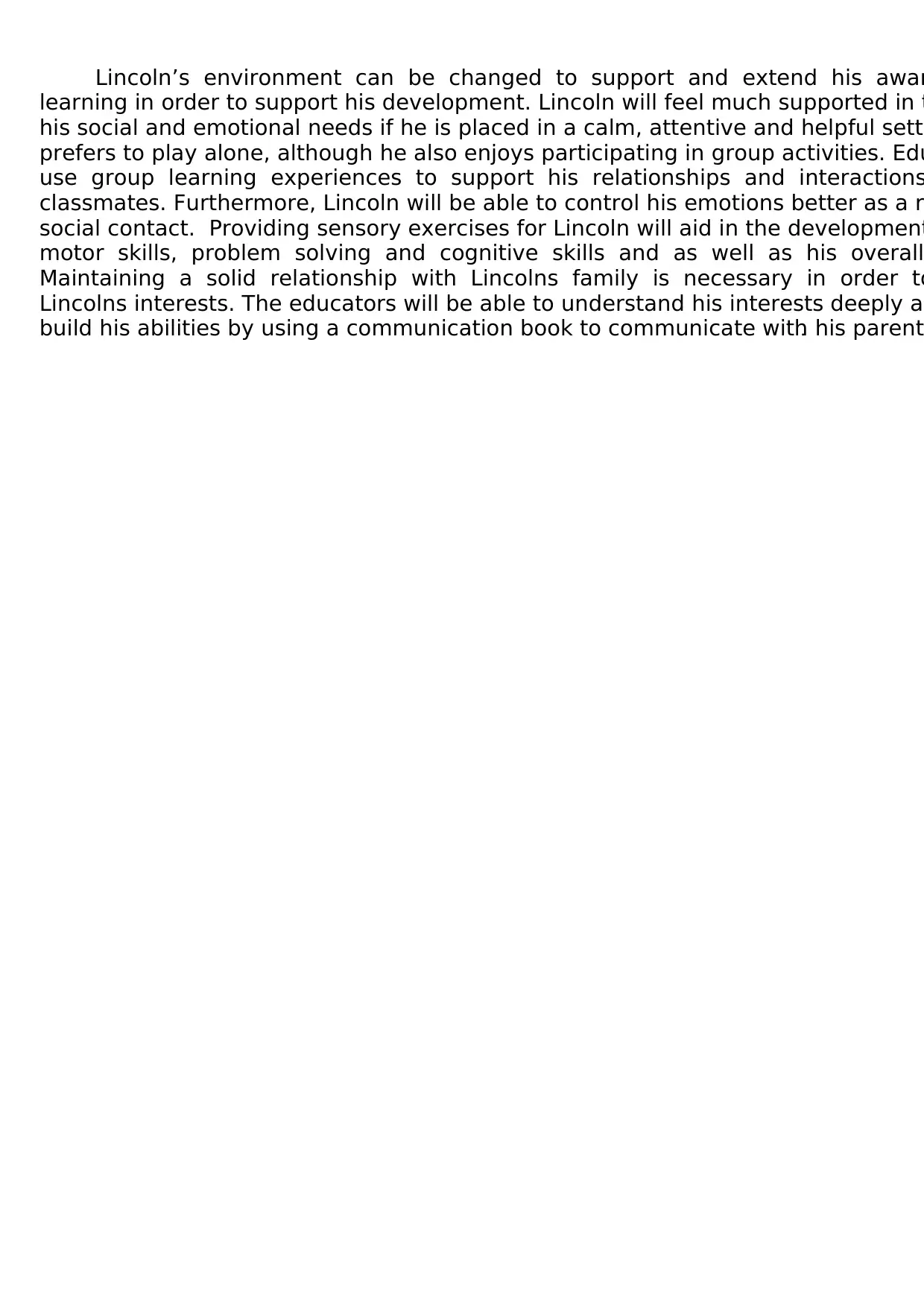
Lincoln’s environment can be changed to support and extend his awar
learning in order to support his development. Lincoln will feel much supported in t
his social and emotional needs if he is placed in a calm, attentive and helpful setti
prefers to play alone, although he also enjoys participating in group activities. Edu
use group learning experiences to support his relationships and interactions
classmates. Furthermore, Lincoln will be able to control his emotions better as a r
social contact. Providing sensory exercises for Lincoln will aid in the development
motor skills, problem solving and cognitive skills and as well as his overall
Maintaining a solid relationship with Lincolns family is necessary in order to
Lincolns interests. The educators will be able to understand his interests deeply an
build his abilities by using a communication book to communicate with his parent.
learning in order to support his development. Lincoln will feel much supported in t
his social and emotional needs if he is placed in a calm, attentive and helpful setti
prefers to play alone, although he also enjoys participating in group activities. Edu
use group learning experiences to support his relationships and interactions
classmates. Furthermore, Lincoln will be able to control his emotions better as a r
social contact. Providing sensory exercises for Lincoln will aid in the development
motor skills, problem solving and cognitive skills and as well as his overall
Maintaining a solid relationship with Lincolns family is necessary in order to
Lincolns interests. The educators will be able to understand his interests deeply an
build his abilities by using a communication book to communicate with his parent.
Paraphrase This Document
Need a fresh take? Get an instant paraphrase of this document with our AI Paraphraser
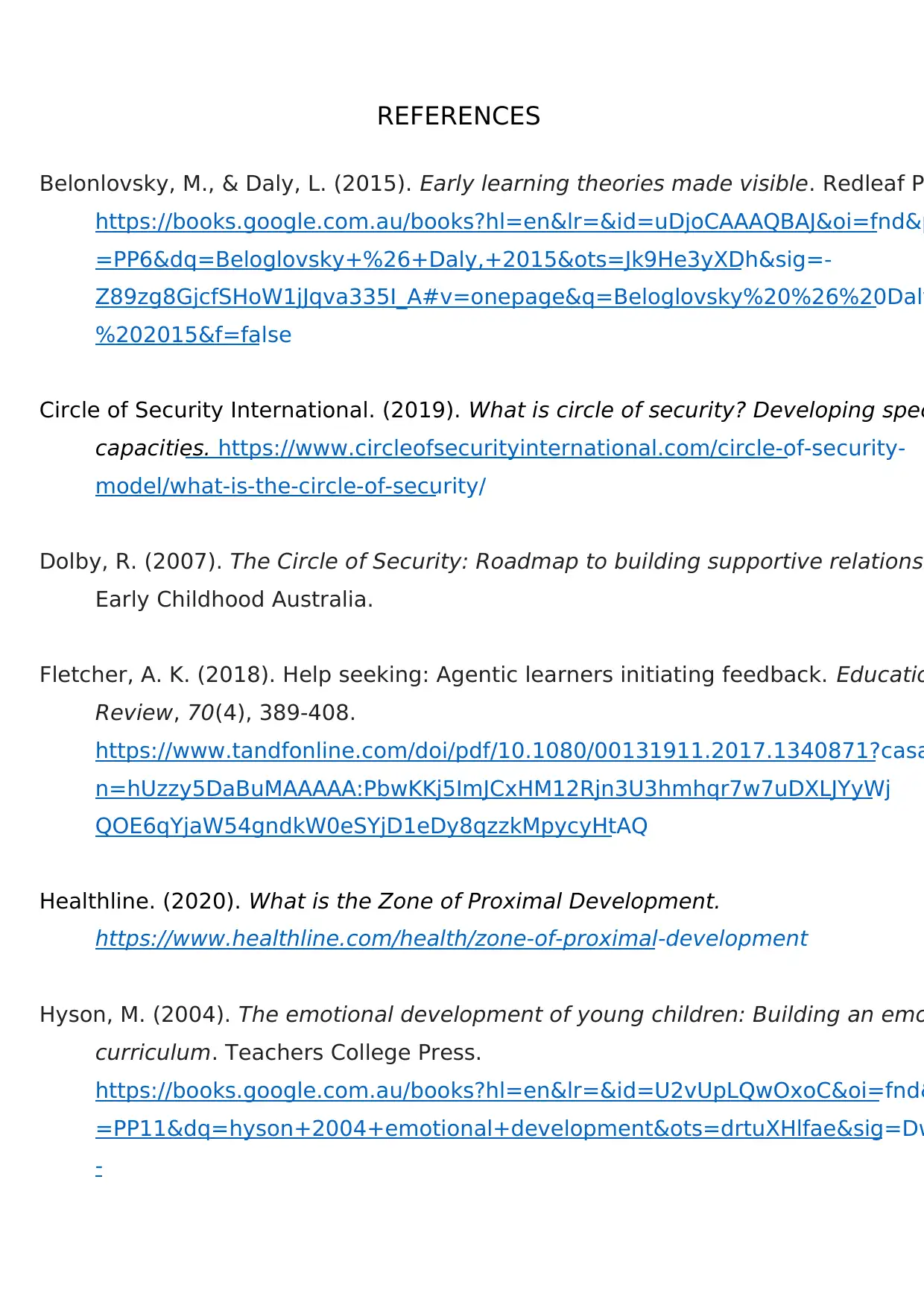
REFERENCES
Belonlovsky, M., & Daly, L. (2015). Early learning theories made visible. Redleaf P
https://books.google.com.au/books?hl=en&lr=&id=uDjoCAAAQBAJ&oi=fnd&p
=PP6&dq=Beloglovsky+%26+Daly,+2015&ots=Jk9He3yXDh&sig=-
Z89zg8GjcfSHoW1jJqva335I_A#v=onepage&q=Beloglovsky%20%26%20Daly
%202015&f=false
Circle of Security International. (2019). What is circle of security? Developing spec
capacities. https://www.circleofsecurityinternational.com/circle-of-security-
model/what-is-the-circle-of-security/
Dolby, R. (2007). The Circle of Security: Roadmap to building supportive relationsh
Early Childhood Australia.
Fletcher, A. K. (2018). Help seeking: Agentic learners initiating feedback. Educatio
Review, 70(4), 389-408.
https://www.tandfonline.com/doi/pdf/10.1080/00131911.2017.1340871?casa
n=hUzzy5DaBuMAAAAA:PbwKKj5ImJCxHM12Rjn3U3hmhqr7w7uDXLJYyWj
QOE6qYjaW54gndkW0eSYjD1eDy8qzzkMpycyHtAQ
Healthline. (2020). What is the Zone of Proximal Development.
https://www.healthline.com/health/zone-of-proximal-development
Hyson, M. (2004). The emotional development of young children: Building an emo
curriculum. Teachers College Press.
https://books.google.com.au/books?hl=en&lr=&id=U2vUpLQwOxoC&oi=fnd&
=PP11&dq=hyson+2004+emotional+development&ots=drtuXHlfae&sig=Dw
-
Belonlovsky, M., & Daly, L. (2015). Early learning theories made visible. Redleaf P
https://books.google.com.au/books?hl=en&lr=&id=uDjoCAAAQBAJ&oi=fnd&p
=PP6&dq=Beloglovsky+%26+Daly,+2015&ots=Jk9He3yXDh&sig=-
Z89zg8GjcfSHoW1jJqva335I_A#v=onepage&q=Beloglovsky%20%26%20Daly
%202015&f=false
Circle of Security International. (2019). What is circle of security? Developing spec
capacities. https://www.circleofsecurityinternational.com/circle-of-security-
model/what-is-the-circle-of-security/
Dolby, R. (2007). The Circle of Security: Roadmap to building supportive relationsh
Early Childhood Australia.
Fletcher, A. K. (2018). Help seeking: Agentic learners initiating feedback. Educatio
Review, 70(4), 389-408.
https://www.tandfonline.com/doi/pdf/10.1080/00131911.2017.1340871?casa
n=hUzzy5DaBuMAAAAA:PbwKKj5ImJCxHM12Rjn3U3hmhqr7w7uDXLJYyWj
QOE6qYjaW54gndkW0eSYjD1eDy8qzzkMpycyHtAQ
Healthline. (2020). What is the Zone of Proximal Development.
https://www.healthline.com/health/zone-of-proximal-development
Hyson, M. (2004). The emotional development of young children: Building an emo
curriculum. Teachers College Press.
https://books.google.com.au/books?hl=en&lr=&id=U2vUpLQwOxoC&oi=fnd&
=PP11&dq=hyson+2004+emotional+development&ots=drtuXHlfae&sig=Dw
-
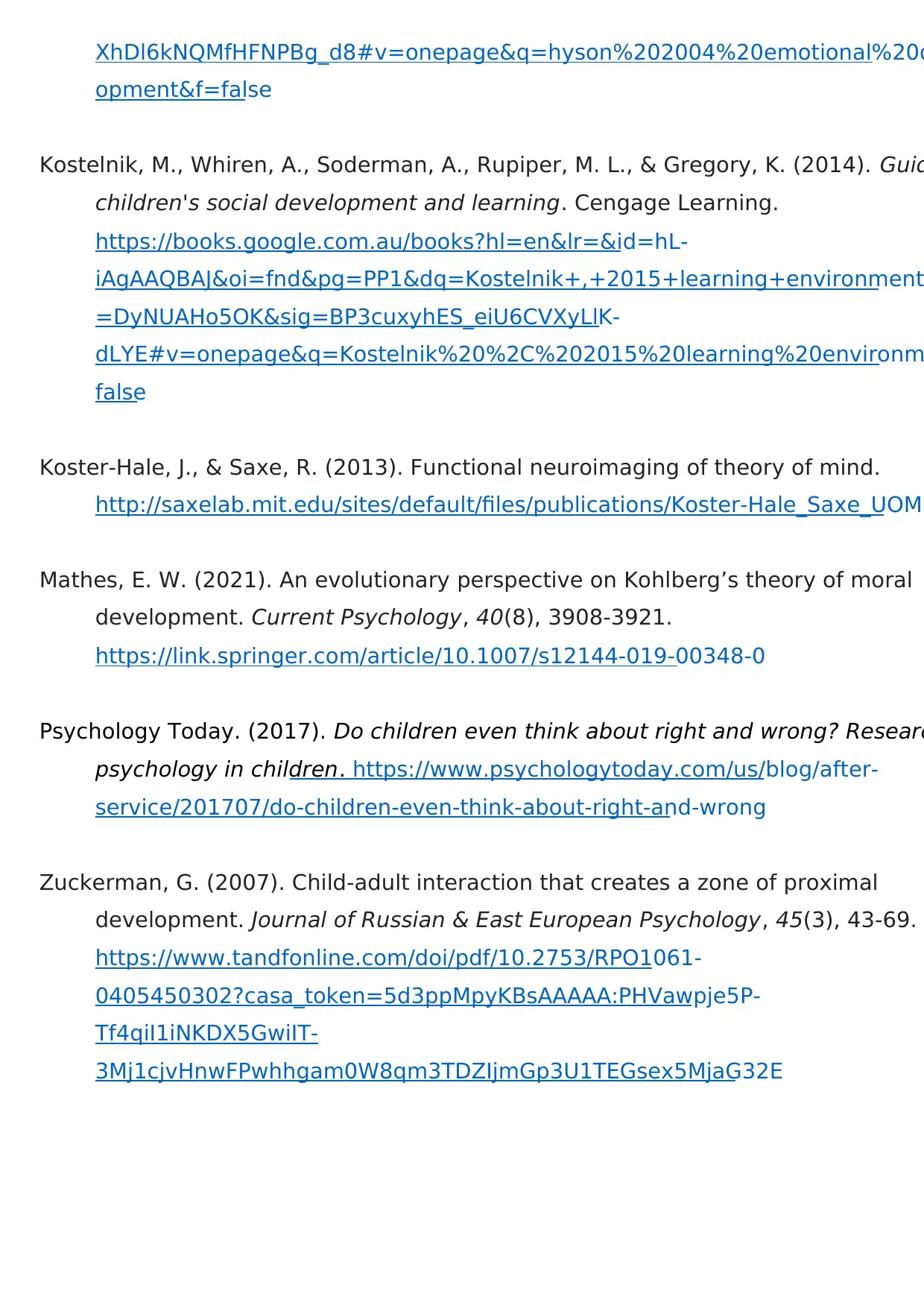
XhDl6kNQMfHFNPBg_d8#v=onepage&q=hyson%202004%20emotional%20d
opment&f=false
Kostelnik, M., Whiren, A., Soderman, A., Rupiper, M. L., & Gregory, K. (2014). Guid
children's social development and learning. Cengage Learning.
https://books.google.com.au/books?hl=en&lr=&id=hL-
iAgAAQBAJ&oi=fnd&pg=PP1&dq=Kostelnik+,+2015+learning+environment
=DyNUAHo5OK&sig=BP3cuxyhES_eiU6CVXyLlK-
dLYE#v=onepage&q=Kostelnik%20%2C%202015%20learning%20environm
false
Koster-Hale, J., & Saxe, R. (2013). Functional neuroimaging of theory of mind.
http://saxelab.mit.edu/sites/default/files/publications/Koster-Hale_Saxe_UOM.
Mathes, E. W. (2021). An evolutionary perspective on Kohlberg’s theory of moral
development. Current Psychology, 40(8), 3908-3921.
https://link.springer.com/article/10.1007/s12144-019-00348-0
Psychology Today. (2017). Do children even think about right and wrong? Researc
psychology in children. https://www.psychologytoday.com/us/blog/after-
service/201707/do-children-even-think-about-right-and-wrong
Zuckerman, G. (2007). Child-adult interaction that creates a zone of proximal
development. Journal of Russian & East European Psychology, 45(3), 43-69.
https://www.tandfonline.com/doi/pdf/10.2753/RPO1061-
0405450302?casa_token=5d3ppMpyKBsAAAAA:PHVawpje5P-
Tf4qiI1iNKDX5GwiIT-
3Mj1cjvHnwFPwhhgam0W8qm3TDZIjmGp3U1TEGsex5MjaG32E
opment&f=false
Kostelnik, M., Whiren, A., Soderman, A., Rupiper, M. L., & Gregory, K. (2014). Guid
children's social development and learning. Cengage Learning.
https://books.google.com.au/books?hl=en&lr=&id=hL-
iAgAAQBAJ&oi=fnd&pg=PP1&dq=Kostelnik+,+2015+learning+environment
=DyNUAHo5OK&sig=BP3cuxyhES_eiU6CVXyLlK-
dLYE#v=onepage&q=Kostelnik%20%2C%202015%20learning%20environm
false
Koster-Hale, J., & Saxe, R. (2013). Functional neuroimaging of theory of mind.
http://saxelab.mit.edu/sites/default/files/publications/Koster-Hale_Saxe_UOM.
Mathes, E. W. (2021). An evolutionary perspective on Kohlberg’s theory of moral
development. Current Psychology, 40(8), 3908-3921.
https://link.springer.com/article/10.1007/s12144-019-00348-0
Psychology Today. (2017). Do children even think about right and wrong? Researc
psychology in children. https://www.psychologytoday.com/us/blog/after-
service/201707/do-children-even-think-about-right-and-wrong
Zuckerman, G. (2007). Child-adult interaction that creates a zone of proximal
development. Journal of Russian & East European Psychology, 45(3), 43-69.
https://www.tandfonline.com/doi/pdf/10.2753/RPO1061-
0405450302?casa_token=5d3ppMpyKBsAAAAA:PHVawpje5P-
Tf4qiI1iNKDX5GwiIT-
3Mj1cjvHnwFPwhhgam0W8qm3TDZIjmGp3U1TEGsex5MjaG32E
1 out of 9
Your All-in-One AI-Powered Toolkit for Academic Success.
+13062052269
info@desklib.com
Available 24*7 on WhatsApp / Email
![[object Object]](/_next/static/media/star-bottom.7253800d.svg)
Unlock your academic potential
© 2024 | Zucol Services PVT LTD | All rights reserved.
